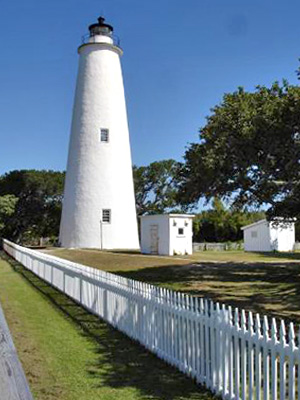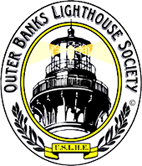OCRACOKE LIGHTHOUSE
Ocracoke Lighthouse
Ocracoke, NC
Latitude: 35° 6' 32.3" N
Longitude: 75° 59' 9.8" W
The first light built to lead ships into Ocracoke Inlet was placed on privately owned Shell Castle Island, once known as “Old Rock.” Most main sources prefer to date it to 1803 although the site could have been established as early as 1798. The first Cape Hatteras Lighthouse was completed in 1803, and construction of both of these early lights was supervised by lighthouse builder Henry Dearborn.
Shell Castle Island consisted of twenty-five acres covered in oyster shells and was a busy port at one time. Island owners John Blount and John Wallace took advantage of the fact that large ships could not navigate the shallow inlets and inner sounds and streams, so they used Shell Island as a transfer point that worked as follows: a large ship would dock at the port at Shell Island, transfer or “lighter” its cargo to a shallow-draft vessel that would then carry the cargo to Ocracoke Inlet where the cargo would again be shifted, if necessary, to even smaller boats to be carried further inland to North Carolina’s main ports. But time and tides changed the channel away from the island and eventually, it was abandoned. The wooden pyramidal tower lasted from circa 1803 until 1818 when it was destroyed by lightning. Seeking a better channel, shipping business had already shifted to ports at Portsmouth and Ocracoke Islands.

Congress approved an act on May 7, 1822 to build a replacement lighthouse "at or near the port of Ocracoke, in the State of North Carolina." The tower and keeper’s quarters were completed in 1823 at a cost of $11,359.35, well below the $20,000 budgeted for the project.
Noah Porter of Massachusetts built the tower of brick with an outer stucco covering; it was initially equipped with a “reflecting illuminating apparatus.” After Fresnel lenses were bought by the U.S. Lighthouse Service, a fourth-order Fresnel lens was installed in 1854 in its "offset" lantern room. This irregularity may have been the result of refitting the lens, which was smaller than the original light source. As another explanation, at least one expert has suggested this irregularity could be the result of positioning a hatch leading into the lens room from the top of the staircase, causing construction workers to offset the placement of the lantern, so that it is not dead-center.
The Ocracoke Lighthouse remains an iconic landmark for the island with its white tower topped by an octagonal lantern that houses the lens. It is the oldest operating lighthouse in the state and originally held significance because ships navigating Ocracoke Inlet needed guidance after the demise of Shell Castle Island Light. During the early 1800s, the inlet was the only viable way for vessels to reach inland ports including Elizabeth City, New Bern, and Edenton until Hatteras and Oregon Inlets opened in 1846, which shifted shipping traffic farther to the north. However, Ocracoke is still considered an "inlet aid to navigation." It is a welcoming harbor light, not a coastal light that warns ships away from the shoreline like the tall lights from Cape Lookout to Currituck Beach.
The lens was removed in 1862 when Confederates were trying to prevent any advantage that the light gave to Union ships; it was reinstalled by Union forces and relit in 1864. Still active and automated, the tower stands about seventy-five feet tall.
Now owned by the National Park Service, the lighthouse, its lens, and other parts of the station were restored between November 2009 and March 2010. However, the lighthouse is not open for public climbing. The lower portion of the tower is only occasionally open when staff or volunteers are available to allow visitors to step inside and look up the old stairs. The Ocracoke Island visitor center is open during summer hours from 9 a.m.-5 p.m. except December 25; it is located adjacent to the ferry docks and includes a bookstore/gift shop and public restrooms.
At the lighthouse, a boardwalk leads from a small parking area to the tower. The walkway is accessible year-round. The keeper’s quarters sits behind a white picket fence on National Park Service land; the light station and surrounding Ocracoke Village mark the southern end of the Cape Hatteras National Seashore.
Ocracoke Village is charming, hosting shops with homespun crafts, unique gifts, books, restaurants, and accommodations. The island is said to have some of the best beaches in the world with ample public access. The village is an ideal place to walk and ride a bicycle. There are plentiful opportunities for local boat trips, even one to take visitors to Portsmouth Island where time stands still–even stiller than on Ocracoke Island.
Directions
Follow NC 12 south of Cape Hatteras for about two miles. A fee-free car and passenger ferry runs from the southern tip of Hatteras Island to the northern end of Ocracoke Island. The ride averages about an hour in duration. After disembarking, travel approximately twelve miles south to reach Ocracoke Village. Turn left onto Lighthouse Road and drive a short distance reach the lighthouse on the right. The lighthouse is set back from the road; be aware that the parking area can accommodate only a few cars at a time.
Other ferries reach Ocracoke Island from Cedar Island and Swan Quarter on the mainland. A fee is charged for these ferries, and reservations are suggested, especially June through mid-September. Visit NCDOT Ferry Routes for up-to-date ferry information to and from Ocracoke, or call 1-800-BY-FERRY.
For more information, visit the Ocracoke Light Station webpage, or you can call National Park Service headquarters at: 252-473-2111. The Ocracoke Visitor Center can be reached at: 252-475-9701.
